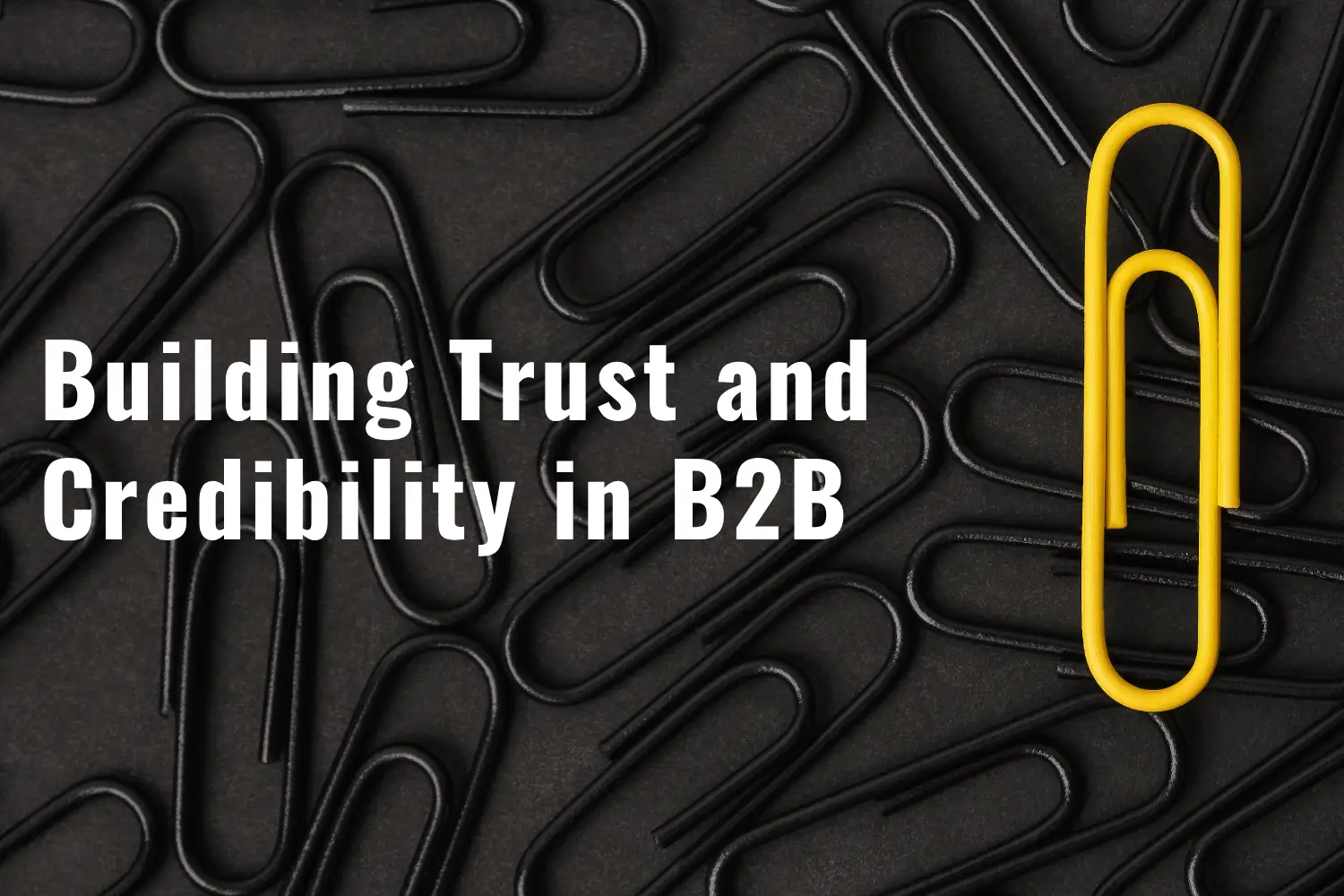B2B Branding is t the process of creating, managing, and communicating a distinctive brand identity for a company that operates in the business-to-business (B2B) space.
In the B2B, where relationships are forged on trust, and decisions hinge on reliability, the importance of a robust brand cannot be overstated. This introductory blog sets the stage for our deep dive into the multifaceted realm of B2B branding. We’ll unravel the significance of brand building, delve into the intricacies of brand identity, explore the delicate balance of brand reputation, and navigate the unique landscape of business-to-business branding.
Brand building in the B2B space is a nuanced art. It’s not just about creating a logo or a memorable slogan; it’s about constructing a narrative that resonates with businesses on a rational and emotional level. We’ll explore the strategic steps involved in building a B2B brand that not only captures attention but also instills confidence and becomes synonymous with excellence.
Table of Contents
ToggleB2B Branding Terminology
Before diving into the intricacies of B2B brand building, it’s essential to understand the key terms that underpin this concept:
Brand Building: The overarching strategy of developing and maintaining a strong brand that resonates with the target audience and achieves the company’s objectives.
Brand Identity: The unique set of characteristics that define a brand, including its name, logo, visual elements, messaging, and tone of voice.
Brand Reputation: The public perception of a brand, shaped by its actions, communication, and customer experiences.
Defining Your Brand’s Purpose and Core Values
Brand Purpose
Your brand purpose is your reason for being. It is what drives you to do what you do and why your company exists. It is the impact you want to make on the world.
Core Values
Your core values are the fundamental beliefs that guide your company’s decisions and actions. They are the principles that you never compromise on, even in challenging times.
How to Find Your Brand’s Purpose and Core Values
To find your brand’s purpose and core values, ask yourself the following questions:
- Why do we exist?
- What is our mission?
- What impact do we want to make on the world?
- What do we believe in?
- What are our non-negotiable principles?
Once you have a good understanding of your brand’s purpose and core values, you can start to develop your brand story.

Brand Story
Your brand story is your narrative. It is the way you communicate your brand’s purpose, core values, and personality to the world. It is what makes your brand unique and relatable.
How to Develop Your Brand Story
To develop your brand story, consider the following questions:
- What is your origin story?
- What challenges have you overcome?
- What are your successes?
- What is your mission?
- What are your values?
- What is your personality?
- What are your goals?
Once you have a strong brand purpose, core values, and brand story, you are well on your way to building a strong brand.
Mission Statement
A mission statement is a short statement that summarizes your company’s purpose. It is a concise and memorable way to communicate what your company is all about.
Brand Essence
Your brand essence is the heart and soul of your brand. It is the unique and intangible quality that makes your brand special. It is what sets you apart from your competitors.
Brand Positioning
Brand positioning is the way you want your brand to be perceived in the market. It is the place you want to occupy in the minds of your target audience.
Once you have a strong foundation of brand purpose, core values, and story, you can start to develop your brand identity.
Developing a Unique Value Proposition (UVP) that Differentiates Your Brand

In the competitive B2B markets, a strong value proposition (UVP) is not just a marketing buzzword; it’s a critical differentiator that can make or break your brand. A well-crafted UVP clearly articulates the unique benefits your company offers to its target customers, setting you apart from the crowd.
What is a Unique Value Proposition (UVP)?
A UVP is a concise and compelling statement that clearly communicates the unique value your company delivers to its customers. It’s a promise to your target audience, highlighting the specific benefits they can expect by choosing your brand over competitors.
Why is a UVP Important for B2B Branding?
In the B2B world, where decision-making is often complex and involves multiple stakeholders, a strong UVP serves as a beacon of clarity. It helps potential customers quickly understand why your company is the best choice for their needs, simplifying their purchasing decisions.
Key Elements of a Strong B2B UVP:
- Unique Benefits: Highlight the specific advantages your company offers that competitors cannot match.
- Customer-Centric Focus: Address the pain points and unmet needs of your target customers.
- Clarity and Conciseness: Keep your UVP short, memorable, and easy to understand.
- Differentiation: Clearly distinguish your brand from competitors by emphasizing your unique strengths.
- Actionable Language: Use compelling language that motivates customers to take action.
Developing Your B2B UVP:
- Identify Your Target Audience: Understand their needs, challenges, and decision-making processes.
- Analyze Competitors: Assess their strengths, weaknesses, and UVPs.
- Define Your Competitive Advantage: What makes your company stand out? What unique benefits do you offer?
- Craft Your UVP: Use clear, concise language that highlights your unique value proposition.
- Validate Your UVP: Test your UVP with potential customers to ensure it resonates and accurately reflects their needs.
Examples of Effective B2B UVPs:
- Software Company: “Our AI-powered software streamlines your operations, saving you time and money while improving efficiency by 20%.”
- Manufacturing Supplier: “We provide high-quality, precision-engineered components that consistently exceed industry standards for durability and reliability.”
- Marketing Agency: “Our data-driven marketing strategies drive measurable results, increasing your website traffic by 30% and generating 25% more qualified leads.”
- Consulting Firm: “Our experienced consultants provide tailored solutions that align with your strategic goals, helping you achieve sustainable business growth.”
- Financial Services Provider: “We offer customized financial solutions tailored to your specific business needs and risk tolerance, helping you secure the capital you need to succeed.”
Remember, your UVP is not a static element; it should evolve as your company and the market landscape change. Regularly review and refine your UVP to ensure it remains relevant and effective in communicating your brand’s unique value.
USP vs UVP
The terms Unique Selling Proposition (USP) and Unique Value Proposition (UVP) are often used interchangeably in marketing, but they have distinct meanings and implications.
USP stands for Unique Selling Proposition, while UVP stands for Unique Value Proposition. They are both important concepts in marketing, but they have different meanings and purposes.
USP
A USP is a single, clear statement that describes what makes a product or service unique and better than its competitors. It should be something that is easy to understand and remember, and it should be relevant to the target audience.
Here are some examples of USPs:
- The only smartphone with a waterproof body.
- The fastest car in the world.
- The most affordable insurance company in the country.
UVP
A UVP is a broader statement that describes the overall benefits that a product or service offers to its customers. It should be clear, concise, and compelling, and it should resonate with the target audience.
Here are some examples of UVPs:
- We help businesses save time and money by automating their operations.
- We provide our customers with peace of mind by offering 24/7 customer support.
- We make it easy for our customers to do business with us by offering a variety of payment options.
Key Differences
The key difference between a USP and a UVP is that a USP is focused on the product or service itself, while a UVP is focused on the benefits that the product or service offers to customers. A USP is also more specific than a UVP.
In general, a USP is a good starting point for developing a UVP. The USP can be used to identify the key benefits that the product or service offers, and then the UVP can be used to communicate those benefits to the target audience.
Feature
Focus
Specificity
Purpose
Crafting a Memorable and Consistent Visual Identity for Your Brand

Visual identity plays a pivotal role in shaping brand perception and establishing a strong connection with target audiences. A well-crafted visual identity serves as a cohesive and recognizable representation of your brand, influencing customer decisions and fostering brand loyalty.
The Importance of Visual Identity in B2B Branding
In the B2B , where rational decision-making often takes precedence over emotional connections, a memorable and consistent visual identity can significantly impact brand perception. A well-designed visual identity can convey professionalism, expertise, and trustworthiness, attributes that are highly valued in B2B interactions.
Key Components of a B2B Visual Identity
- Logo: The cornerstone of your brand’s visual identity, your logo should be distinctive, memorable, and scalable across various mediums. Consider a logo that encapsulates your brand’s essence and reflects your industry.
- Color Palette: Colors evoke emotions and set the tone for your brand. Choose a color palette that aligns with your brand personality and resonates with your target audience.
- Typography: Typography choices can convey authority, professionalism, or approachability. Select typefaces that complement your brand’s overall aesthetic and messaging.
- Imagery and Photography: Images and photography play a crucial role in storytelling and brand communication. Choose visuals that align with your brand identity and resonate with your target audience.
Ensuring Visual Consistency
Consistency is paramount in maintaining a strong visual identity. Establish clear guidelines for the use of your brand’s visual elements across all touchpoints, including marketing materials, website, social media, and product packaging.
Designing for B2B Audiences
- Professionalism: Prioritize a clean, polished, and sophisticated aesthetic that conveys expertise and trustworthiness.
- Clarity: Ensure your visuals are easy to understand and interpret, avoiding overly complex or abstract designs.
- Relevance: Select visuals that are relevant to your industry and resonate with your target audience’s interests and needs.
Creating a Memorable Visual Identity
- Distinctiveness: Stand out from competitors by developing a unique visual aesthetic that reflects your brand’s individuality.
- Timelessness: Avoid trendy or fleeting design elements that may quickly become outdated.
- Versatility: Ensure your visual identity can be adapted to various applications and platforms without losing its impact.
- Emotional Connection: Evoke positive emotions and create a connection with your target audience through your visuals.
Invest in Professional Design Expertise
While DIY design tools may seem appealing, investing in professional design expertise is crucial for creating a high-quality and impactful visual identity. Experienced designers can guide you through the process, ensuring your visual identity aligns with your brand strategy and resonates with your target audience.
Remember, your visual identity is a vital aspect of your B2B branding. By crafting a memorable and consistent visual identity, you can effectively communicate your brand’s value proposition, establish a strong brand presence, and ultimately drive business success.
As you embark on the journey of crafting a memorable and consistent visual identity for your brand, keep in mind that these visual elements are not just aesthetic choices—they are strategic decisions that communicate your brand’s values, personality, and professionalism. In the subsequent blog posts of this series, we’ll delve into incorporating your visual identity into broader brand experiences and communication strategies. Stay tuned for insights on bringing your brand to life visually in the B2B arena.
Communicating Your Brand Message Effectively through Content Marketing

Content marketing plays a pivotal role in establishing thought leadership, nurturing leads, and driving brand awareness. By consistently creating and sharing high-quality content, B2B companies can position themselves as trusted experts, engage with their target audience, and ultimately achieve their business goals.
Crafting a B2B Content Marketing Strategy
To effectively communicate your brand message through content marketing, a well-defined strategy is essential. Your strategy should align with your overall marketing objectives and target audience needs.
Key Elements of a B2B Content Marketing Strategy:
- Target Audience: Clearly identify your target audience, understanding their pain points, interests, and decision-making processes.
- Content Goals: Define specific goals for your content marketing efforts, such as generating leads, increasing website traffic, or establishing thought leadership.
- Content Types: Determine the types of content that resonate with your target audience, such as blog posts, infographics, videos, or webinars.
- Content Distribution Channels: Identify the channels where your target audience consumes content, such as social media, email, or industry publications.
- Content Measurement: Establish metrics to track the performance of your content and measure its impact on your business goals.
The Power of Brand Storytelling
Brand storytelling is an effective approach to engage your target audience and connect with them on an emotional level. Through compelling narratives, you can showcase your company’s values, expertise, and commitment to solving customer problems.
- Authenticity: Be genuine and true to your brand’s core values.
- Human Connection: Evoke emotions and create a sense of relatability with your audience.
- Problem-Solving: Demonstrate how your products or services address customer pain points.
- Consistency: Maintain a consistent voice and tone across your storytelling efforts.
Creating Thought Leadership Content
Thought leadership content establishes your company as an expert in your industry, attracting potential customers and building trust. By sharing valuable insights and perspectives, you can position your brand as a trusted resource.
- Industry Reports: Share in-depth research and analysis on relevant industry trends.
- Webinars and Podcasts: Host discussions with industry experts and thought leaders.
- Guest Articles: Contribute articles to industry publications and blogs.
- Original Research: Conduct and share original research that adds to the industry’s knowledge base.
Leveraging Social Media for B2B Marketing
Social media platforms offer powerful channels to connect with your target audience and amplify your brand message. Tailor your social media strategy to align with your B2B audience’s preferences and behaviors.
- Content Curation: Share industry news, insights, and thought leadership articles.
- Engagement: Respond to comments, answer questions, and participate in relevant discussions.
- Community Building: Create groups or forums for industry professionals to connect.
- Paid Advertising: Utilize targeted social media advertising to reach specific audience segments.
Measuring the Impact of B2B Content Marketing
Regularly measure the performance of your content marketing efforts to assess its effectiveness and make data-driven decisions. Track metrics such as website traffic, lead generation, social media engagement, and content consumption.
Learn more about B2B Content Marketing: https://mochatouch.com/blog/b2b-content-marketing/
Implementing Strategies to Build Trust and Credibility in the B2B Space

Trust and credibility are essential for long-term success. B2B buyers often make significant investments in products or services, and they need to have confidence in the companies they partner with. By implementing effective trust-building strategies, B2B companies can establish themselves as reliable partners, attract new customers, and foster lasting relationships.
Key Strategies for Building Trust and Credibility in B2B
- Demonstrate Expertise: Establish your company as a thought leader in your industry by sharing valuable insights, conducting research, and participating in industry events.
- Highlight Customer Success Stories: Showcase the positive impact your products or services have had on your customers through testimonials, case studies, and success stories.
- Maintain Transparency and Honesty: Be open and upfront with your customers about your products, services, and pricing. Avoid making exaggerated claims or misleading statements.
- Prioritize Customer Service: Provide exceptional customer service by offering prompt responses, resolving issues efficiently, and going the extra mile for your customers.
- Build Industry Partnerships: Collaborate with reputable companies in your industry to demonstrate your commitment to quality and innovation.
- Maintain Consistent Quality: Ensure that your products and services consistently meet or exceed customer expectations. Implement quality control measures and gather customer feedback to maintain high standards.
- Adhere to Ethical Standards: Conduct business with integrity and uphold ethical practices. This includes respecting intellectual property, treating employees fairly, and engaging in responsible environmental practices.
- Seek Certifications and Accreditations: Obtain certifications and accreditations from recognized organizations to validate your expertise and commitment to quality.
The Role of Customer Testimonials and Case Studies
Customer testimonials and case studies are powerful tools for building trust and credibility in the B2B space. These real-world examples provide tangible evidence of the value your company delivers to customers.
Benefits of Customer Testimonials and Case Studies:
- Increase credibility: Showcase positive customer experiences to establish your company’s reputation.
- Enhance brand perception: Demonstrate the impact your products or services have on customers’ businesses.
- Build trust: Provide social proof that your company is reliable and trustworthy.
Effective Practices for Gathering and Utilizing Testimonials and Case Studies:
- Seek out satisfied customers: Identify customers who have had positive experiences with your company.
- Gather in-depth information: Conduct thorough interviews or surveys to gather detailed feedback.
- Focus on specific results: Highlight the measurable outcomes your company has achieved for customers.
- Use a variety of formats: Present testimonials and case studies in various formats, such as written narratives, videos, or infographics.
Industry Partnerships and Their Impact
Partnerships with reputable companies in your industry can significantly enhance your brand’s credibility and visibility. These partnerships can take various forms, such as co-branding initiatives, joint marketing campaigns, or technology integrations.
Benefits of Industry Partnerships:
- Leverage partner expertise: Gain access to complementary skills, knowledge, and resources.
- Expand market reach: Access new customer segments and broaden your brand’s reach.
- Enhance brand reputation: Associate your company with trusted partners in your industry.
- Strengthen credibility: Demonstrate your commitment to innovation and collaboration.
Tips for Successful Industry Partnerships:
- Choose partners strategically: Align with companies that share your values, target audience, and overall business goals.
- Establish clear objectives: Define the specific goals you aim to achieve through the partnership.
- Communicate effectively: Maintain open and transparent communication channels with your partners.
- Share resources and expertise: Collaborate effectively and share resources to maximize the benefits of the partnership.



